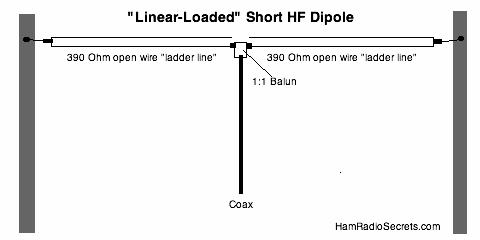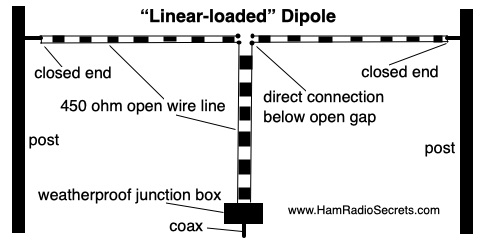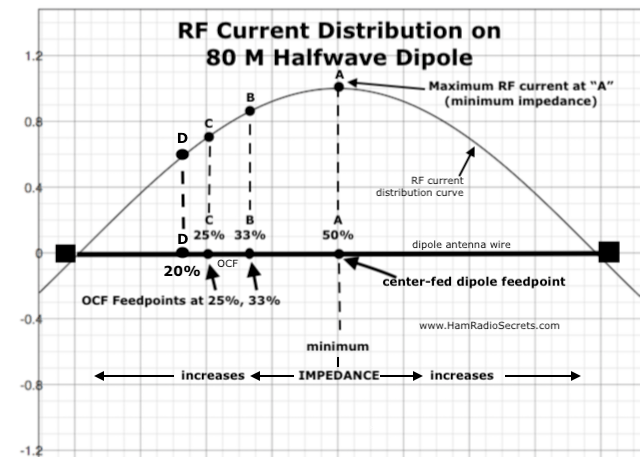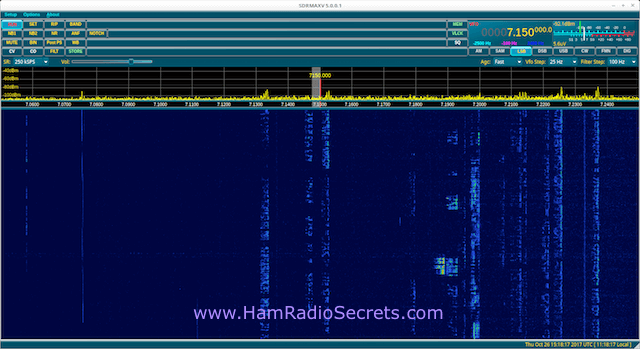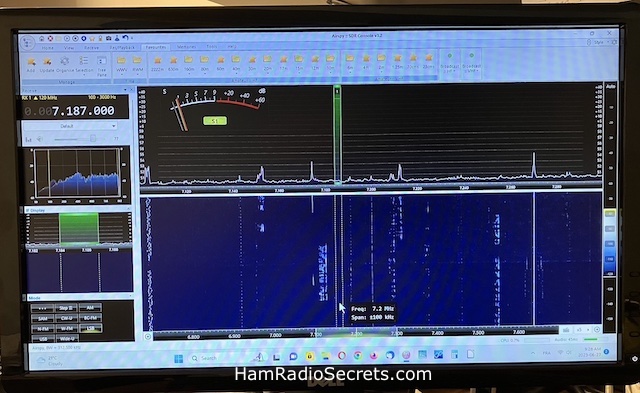Short Ham Antennas
For HF
With Linear Loading
You may have heard that short ham antennas are not as efficient, nor as effective as a "full length" half-wave dipole, regardless of the configuration chosen.
Good news! I describe in this article the only exception I know of ... that actually works!
To be honest, even if effective, the antenna described below will tune somewhat sharply (narrower 2:1 SWR bandwidth) than full half wave dipole.
When you don't have the space, you have to accept a few compromises.
However, this "shortened" antenna will not disappoint you! John, OZ3PAX built one for the 17 meter band. Read his comment here.
I believe the details of this technique were first published a while back by John Stanford, NN0F.
Linear Loaded
Short Ham Antennas
For many ham radio operators, it is not feasible to put up a full length dipole on HF.
But, a linearly loaded dipole just might fit in your available space!
A linearly loaded dipole, as illustrated below...
- ... is about 30-35% shorter than a "classic half-wave dipole" at the same frequency of resonance!
- ... has a radiation resistance around 35 Ohms. (You will need an impedance matching tuner at the other end of the coax!)
- ... just as effective as a "full length" half-wave dipole! :-)
Note that it "looks" like a folded dipole, but the top part is open! You should add a ceramic end-insulator in the opening, to add mechanical strength. (The insulator is omitted in the drawing to make the opening obvious;-).
A More Efficient Version
A more efficient version would be to feed a linear-loaded dipole short ham antenna directly with 450 ohm ladder line or 300 ohm twinlead.
As I work mostly QRP, I need to minimize RF losses as much as possible. Ladder line, and to a certain extent twinlead, are much less lossy transmission lines than coax.
I only use RG-8X coax to enter the radio room and to connect to a tuner. The coax is connected directly to the ladder line outside, just before it enters the shack. The connection is protected inside a weatherproof box.
You must use a RF choke on the coax, outside, before it enters the shack. To that end, you can use a coax choke, as described on this other page of this website.
Or you can use ferrite chokes that clip on the coax. (You can tell that you need more RF chokes when your tuner has trouble stabilizing on a setting when you transmit.)
As always, I recommend an "L" network tuner for maximum efficiency.
Here is what Tim G5TM (alias for 2EOTWG) had to say about this antenna:
"The 40m linear loaded dipole worked very well so I took away the coax and fed it with 300 ohm ribbon line. Wow! (it now) tunes 10-80 ... never thought it would tune 80 but it does and it works very well ... Thanks for sharing the idea and your advice." (Tim was using a IC-7300 with its internal automatic tuner.)
Shorter Dimensions!
Here are "ballpark" dimensions for a linearly loaded dipole for each ham radio band. These dimensions are intentionally slightly long! You will have to obtain the final dimensions experimentally, on site, by "pruning" to resonance.
Have you forgotten the technique to prune a dipole to resonance? Refresh your memory on the page about the ham radio dipole!
Linearly-Loaded Dipole
Approximate Dimensions
10M (28.5 MHz) 3.5 m. (11.5 ft.)
12M (24.9 MHz) 4.0 m. (13.2 ft.)
15M (21.1 MHz) 4.73 m. (15.5 ft.)
17M (18.1 MHz) 5.51 m. (18.1 ft.)
20M (14.1 MHz) 7.08 m. (23.2 ft.)
30M (10.1 MHz) 9.89 m. (32.44 ft.)
40M (7.1 MHz) 14.06 m. (46.14 ft.)
80M (3.6 MHz) 27.74 m. (91.0 ft.)
160M (1.85 MHz)53.97 m. (177.08 ft.)
The lengths given in the chart above are those of the full overall length (total breadth) of the bottom half of the linear-loaded dipole. The dimensions include the width between the balun connections.
The gap in the top section can be a few inches wide at HF (ex. the length of a normal end insulator).
Construction Of Linear Loaded
Short Ham Antennas
I use commonly available 390 Ohm "ladder line" with #14 stranded, copper-clad conductors. It is sturdy and lasts for years. 450 Ohm ladder line will work just as well.
For the central "attachment" I use two LadderLoc center insulators, head-to-head. (I used a BNC to dual-pole center connector for an indoor version of a linear-loaded 10 meter dipole).
The extremities of the ladder line linearly loaded dipole are connected together.
After pruning the ends to get resonance at the desired frequency, I recommend soldering them together to ensure a long-lasting electrical bond. If not soldered, copper oxidization will eventually render the connections resistive and unreliable.
The top gap can be 3-4 inches wide. It's not critical for use on HF.
I recommend 3/16 in. Mil Spec Dacron® rope to tie the ends to tall supports such as trees.
Bonus Configurations!
Linear-loaded short ham antennas do not have to be limited to horizontal installations!
You can save even more space by installing them as "slopers", inverted "V"s and inverted "U"s.
I describe these configurations in detail on space-saving ham radio HF antennas.
How Does Linear Loading Work?
An antenna system is composed of the antenna, its transmission line (and a balun or UNUN if one is used) and the antenna tuner when one is used.
Linear loading is a technique to obtain a shorter, yet still resonant and efficient antenna on the frequency for which it is designed.
Let's take the example of a linear-loaded dipole for 40 meters.
The 40-meter linear-loaded dipole is essentially a single band antenna, but it can also be efficient on 21 MHz, its third harmonic.
Of course, it can also be coaxed into serving on other bands with an antenna tuner... and the tuner will fool you into thinking that you can, just because you can bring the SWR of the entire antenna system down!
The tuner serves to hide any mismatch between the antenna system's impedance and your transceiver's input/output impedance. The tuner transforms, within itself, the mismatched impedance of the antenna system to the 50 ohms impedance of the transceiver. The tuner is an impedance transformer. It does NOT render the antenna resonant at the other end of the transmission line.
Just be aware that the linear-loaded dipole will be much (much) less efficient on other frequency bands than its fundamental frequency of resonance which, in this case, is in the 40-meter band and its third harmonic in the 15-meter band.
What is the purpose of linear loading short ham antennas?
To explain how the linear-loaded dipole antenna works, let's recall the theory of resonant circuits and apply it to an antenna.
When we take a length of wire to form a coil, the mutual coupling between the turns of the coil increases the inductance and the proximity of the coil turns form a capacitor contributing the necessary capacitance to yield a frequency of resonance.
A dipole antenna at resonance is a resonant circuit. It is the result of the combination of inductance (L) and capacitance (C).
Therefore, think of a dipole antenna as a pair of coils that have been stretched out to form straight wires, one on each side of the feed point (hence the name 'dipole').
Now imagine that you wind a portion of wire on each side of the dipole's feed point to form a helical coil terminated by a remaining straight length of wire. You end up with a coil-loaded dipole with a reduced overall "wingspan". The coils introduce lumped inductances in the antenna, replacing part of the stretched-out antenna wire. That's the most popular way of obtaining short ham antennas.
Now, in the case of the linear-loaded dipole, we simulate a large one-turn coil on each side of the feedpoint by folding back each half of the dipole antenna on itself.
The folded back portion of wire interacts with the antenna wire above (or below, depending on how it is installed). The frequency of resonance of the dipole antenna is the result of the self-coupling of the two wires on each side of the antenna feedpoint.
In other words, each side of the antenna becomes part of a resonant circuit with inductance (length of wire) and capacitance (proximity of wires to each other forming a capacitor).
Linear loading allows preserving the resonance of a shortened dipole for the same given frequency of a regular size dipole.
Can the linear-loading technique be applied to a multi-band fan dipole? Read on and find out...
If you really want to go deeper into the theory of short antennas, see this reference.
Have fun! See you on HF.
73 de VE2DPE
73 de VE2DPE
Claude Jollet
104-30 avenue des Berges,
Notre-Dame-des-Prairies, Québec, Canada J6E 1M9
QTH Locator: FN36gb
Disclosure
If
you make a purchase via a link on this site, I may receive a small
commission on the transaction, at no extra cost to you. Thank you!
(One word queries work best)
HF Antennas
Section
Contents
VHF/UHF Antennas
FOUND THIS
SITE
USEFUL?
VE2DPE
Is a member
in good standing
of
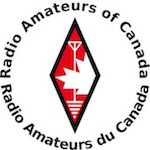

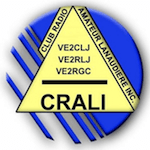
Also a proud member of an international community of solopreneurs
using SoloBuildIt!
(SBI!)
to promote my self-published eBooks
since 2005.
See my review
of this unique product for online businesses.
CQ CQ CQ
If you have a question, a comment or a topic you would like me to cover, please do not hesitate to ask here.
